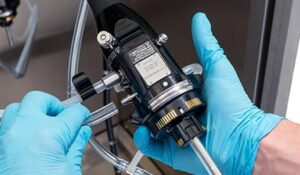 According to a recent study published in the American Journal of Infection Control, storing endoscopes in an automated cabinet with channel drying functionality effectively reduced moisture and bacterial growth in the scopes. Because endoscopes are reusable medical instruments, minimizing the amount of bacterial growth in the periods between procedures can dramatically improve patient safety.
According to a recent study published in the American Journal of Infection Control, storing endoscopes in an automated cabinet with channel drying functionality effectively reduced moisture and bacterial growth in the scopes. Because endoscopes are reusable medical instruments, minimizing the amount of bacterial growth in the periods between procedures can dramatically improve patient safety.
The study, performed by researchers at UCLA Health, compared the drying effectiveness and microbial growth of automated cabinets with channel drying capability to standard endoscope storage cabinets. A recent article by Gina Shaw at Gastroenterology and Endoscopy News detailed the results:
“Before the endoscopes were placed in the drying cabinets, they were put through a high-level disinfection (HLD) cycle in an automated endoscope reprocessor (AER).
After one half-hour of drying, all the scopes in both cabinets still had residual moisture in both internal and external channels. At the one-hour mark, scopes in the automated cabinet had no remaining moisture in the internal channels but had moisture on external surfaces, whereas scopes in the standard cabinet retained moisture in the internal channels and external surfaces. By three hours, scopes in the automated cabinet were found to be completely dry in both the internal channels and external surfaces, but moisture remained in both internal channels and external surfaces of the scopes in the standard cabinet. At 24 hours, external surfaces of endoscopes in the standard cabinet were dry, but the internal channels still retained some moisture.
In the second part of the study, the investigators inoculated each endoscope with Pseudomonas aeruginosa after it underwent HLD in an AER and compared rates of bacterial growth between the cabinets. Dr. Muthusamy and his team found significantly more colony-forming units (CFUs) in the endoscopes dried in the standard cabinets. “After 48 hours of drying, the automated cabinet resulted in 8 log, 7 log and 9 log fewer recovered organisms for bronchoscopes, colonoscopes and duodenoscopes, respectively,” compared with the standard cabinet, they noted.
“For decades, failures in endoscope reprocessing have primarily been attributed to human error resulting in breaches of existing reprocessing protocols. It is becoming increasingly apparent that although human error can play a role, existing protocols for endoscope reprocessing may also be insufficient. If moisture remains after endoscope reprocessing, recolonization with bacteria during endoscope storage can occur. Without the drying step in endoscope reprocessing, fluid may reside within endoscopes for days,” according to the investigators.”
Read the full article here: Automated Cabinets Found Superior for Endoscope Drying
As Dr. Muthusamy revealed through the study, automated endoscope drying cabinets significantly reduce the risk of passing deadly bacteria between patients by practically eliminating dangerous moisture build-up. One endoscope channel drying and storage cabinet that can bring these benefits to hospitals is iRIScope from Mobile Aspects, which was introduced in the last several years to guide healthcare providers through the proper, society-recommended HLD protocols every single time a scope is reprocessed. The system includes smart storage cabinets that allow scopes to hang vertically with forced air running through the channels. The system’s main benefits over other drying cabinets include a shortened drying cycle and the ability to use ambient air rather than setting up an expensive connection with the hospital’s medical air system.
